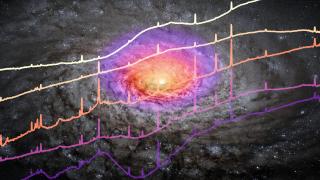Bibcode
González-Martín, Omaira; Masegosa, Josefa; García-Bernete, Ismael; Ramos Almeida, Cristina; Rodríguez-Espinosa, José Miguel; Márquez, Isabel; Esparza-Arredondo, Donaji; Osorio-Clavijo, Natalia; Martínez-Paredes, Mariela; Victoria-Ceballos, César; Pasetto, Alice; Dultzin, Deborah
Referencia bibliográfica
The Astrophysical Journal
Fecha de publicación:
10
2019
Revista
Número de citas
30
Número de citas referidas
27
Descripción
At distances from the active galaxy nucleus where the ambient temperature falls below ̃1500-1800 K, dust is able to survive. It is thus possible to have a large dusty structure present that surrounds the active galaxy nucleus. This is the first of two papers aiming at comparing six dusty torus models with available spectral energy distributions, namely, Fritz et al., Nenkova et al., Hönig & Kishimoto, Siebenmorgen et al., Stalevski et al., and Hönig & Kishimoto. In this first paper we use synthetic spectra to explore the discrimination between these models and under which circumstances they allow us to restrict the torus parameters, while our second paper analyzes the best model to describe the mid-infrared spectroscopic data. We have produced synthetic spectra from current instruments GTC/CanariCam and Spitzer/IRS and future James Webb Space Telescope (JWST)/MIRI and JWST/NIRSpec instruments. We find that for a reasonable brightness (F 12 μm > 100 mJy) we can actually distinguish among models except for the two pairs of parent models. We show that these models can be distinguished based on the continuum slopes and the strength of the silicate features. Moreover, their parameters can be constrained within 15% of error, irrespective of the instrument used, for all the models except Hönig & Kishimoto. However, the parameter estimates are ruined when more than 50% of circumnuclear contributors are included. Therefore, future high spatial resolution spectra such as those expected from JWST will provide enough coverage and spatial resolution to tackle this topic.
Proyectos relacionados

Grupo de Estudios de Formación Estelar GEFE
El proyecto interno GEFE está enmarcado en el proyecto coordinado, ESTALLIDOS, financiado por el plan nacional desde el año 2001. El ultimo proyecto aprobado es ESTALLIDOS 6.0 (AYA2016- 79724-C4-2-P). En el proyecto GEFE trabajamos en base al caso científico del proyecto ESTALLIDOS 6.0. Los estallidos de formación estelar (Starbursts o SB) son
Casiana
Muñoz Tuñón

Actividad Nuclear en Galaxias: una Perspectiva 3D del Núcleo y su Entorno
Nuestro proyecto puede dividirse en dos líneas principales de investigación. En primer lugar, el estudio de los vientos producidos por cuásares luminosos oscurecidos y del impacto que estos tienen en sus galaxias anfitrionas (retroalimentación del AGN). Para ello hemos obtenido observaciones en el óptico e infrarrojo cercano con el Gran Telescopio
Cristina
Ramos Almeida